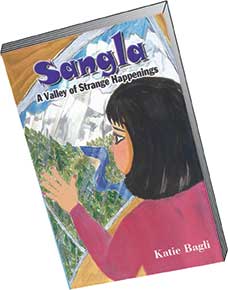Nimesh Ved
Twice during the past two years, I have been fortunate to trek in Himachal Pradesh and have come across some of the species that the author mentions, including choughs and vultures. This book took me back to the endearing mountains. Sangla: A valley of strange happenings is a story of a four-year young girl from Mumbai who invests one year of her life in the mountains and her experiences during the period. It touches upon different aspects of mountain life like changing seasons when the snow keeps the family inside the house to customs like the to-be bride weaving the shawl she would wear during her marriage.
 One experiences some beautiful moments as one reads the book. These stand out. The very first page says ‘To the majestic deodar trees in the Himalayas’; not very common to come across a book dedicated to trees. The 8th chapter (the 136 page book is divided into 14 chapters) on deodars has the line ‘father and daughter stretched out their arms around the deodar’s wide trunk giving it a warm hug and felt its spiritual energy’. Simplest of actions but one that could change lives; one wishes more parents did this. The author does love deodars, no two thoughts on that. She also likes and knows children. When Tara was ‘bursting to tell someone her secrets but was too scared to tell any of the grown ups’ or when she looks at the moon and says ‘it seems to be balancing itself on peak of Kinner Kailash’.
One experiences some beautiful moments as one reads the book. These stand out. The very first page says ‘To the majestic deodar trees in the Himalayas’; not very common to come across a book dedicated to trees. The 8th chapter (the 136 page book is divided into 14 chapters) on deodars has the line ‘father and daughter stretched out their arms around the deodar’s wide trunk giving it a warm hug and felt its spiritual energy’. Simplest of actions but one that could change lives; one wishes more parents did this. The author does love deodars, no two thoughts on that. She also likes and knows children. When Tara was ‘bursting to tell someone her secrets but was too scared to tell any of the grown ups’ or when she looks at the moon and says ‘it seems to be balancing itself on peak of Kinner Kailash’.
At one point the complex issue of habitat loss that is making the leopard visit human homes is simply and succinctly put. There is a problem and building fences around homes will not help. As Aama put it ‘it is the wood cutting that should be stopped’.
The book leads to a few situations where one is keen to know more but the author does not sufficiently build upon these. Like Tara was ‘in the vultures’ nest the whole day’; it would have been fascinating to read what a young one from Mumbai saw and felt at the nest of one of our largest birds in the mountains. Similarly one was keen to know why Tara’s parents in today’s time, when time is at premium, agreed to her dropping out of the school for a year. A welcome move indeed, but the author later contradicts herself when she writes that Tara’s mother feels that Tara can get good education only ‘back at home in Mumbai’. Is not a ‘gap year’ an education, a learning with few parallels, in itself?
Few pages into the book one realizes that the editing could have been better. The pages are generously sprinkled with clichés, and the adjectives, after some pages, tend to irritate and hinder the flow rather than help. It would have helped to put in a map, even a sketch map. Similarly, local names would have added value, including that of food items like ‘stew’ and ‘pan-cakes’. The author mentions in the preface that ‘the events that take place are purely fictional’ but perhaps she could have been more realistic when she talks of a fine for cutting trees, ‘pay a fine of 5 lakh rupees or be locked up in jail for 5 years’ and black-necked cranes migrating, ‘easily about a thousand in that batch’. Both the fines and number of black-necked cranes are way lower in our country today!
There were portions which were difficult to understand. What was the point in mentioning, on more than one occasion, of spirits and how they could be warded off with prayers? Similarly, why on earth draw the parallel of the beauty of ‘bare fields’ in Sangla with ‘putting green on a golf course’. Golf courses have a privileged few cornering resources meant for many besides being green scars on our environment. Finally one also wishes there were questions raised in lieu of the ‘black and white’ approach to issues like tree felling.
The author enjoys exploring nature education and blogs at http://nimesh-ved.blogspot.com/. He can be reached at nimesh.explore@gmail.com.
